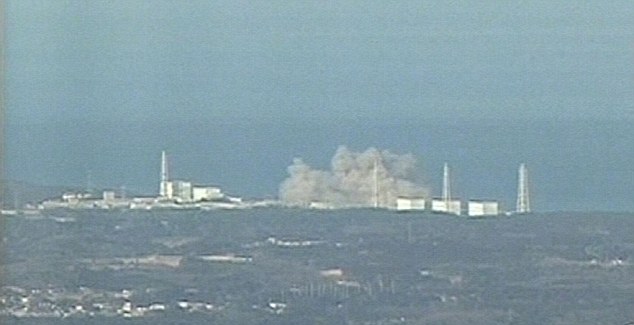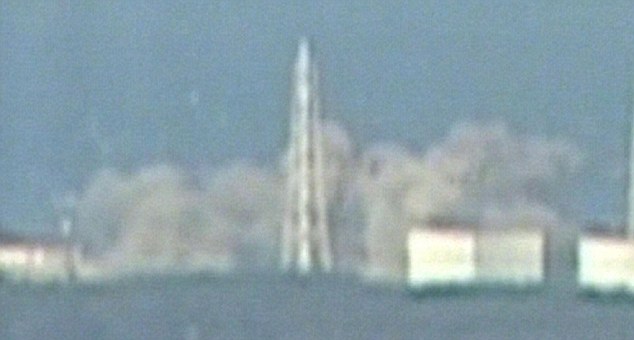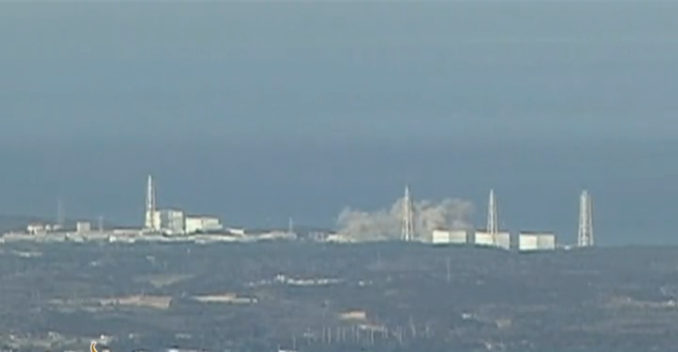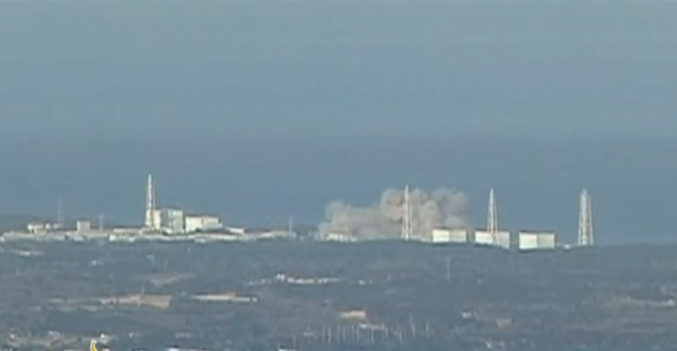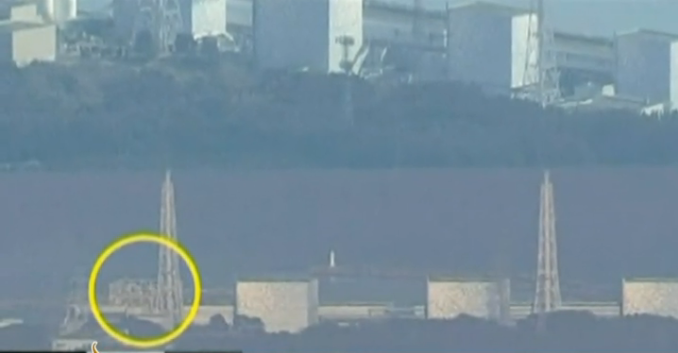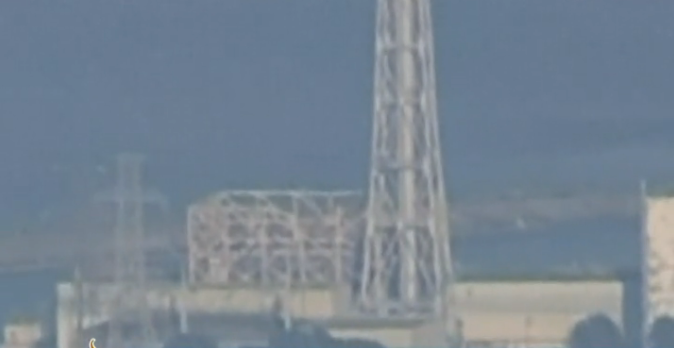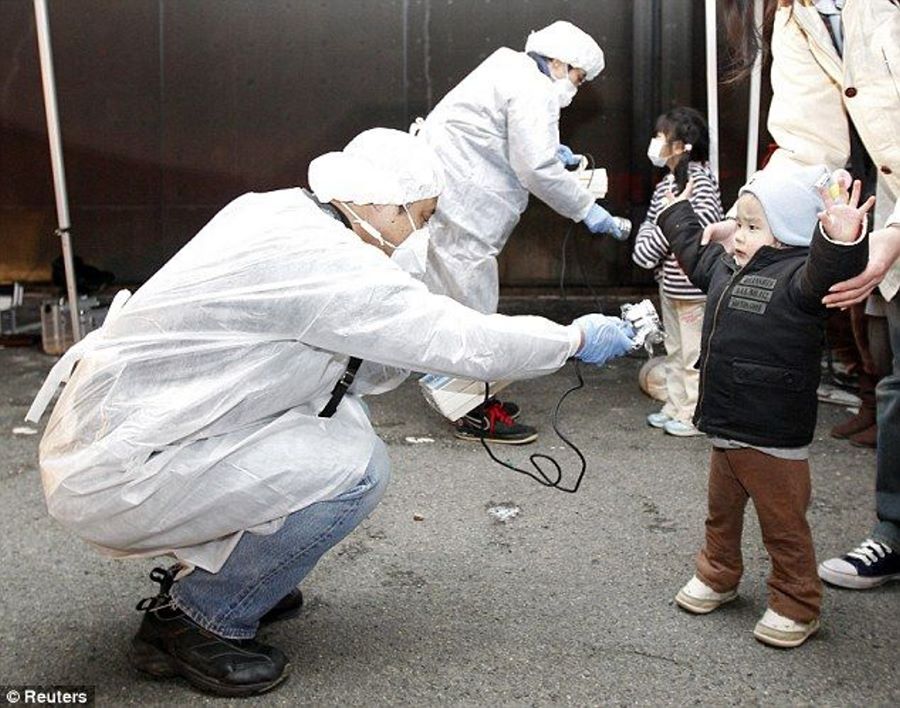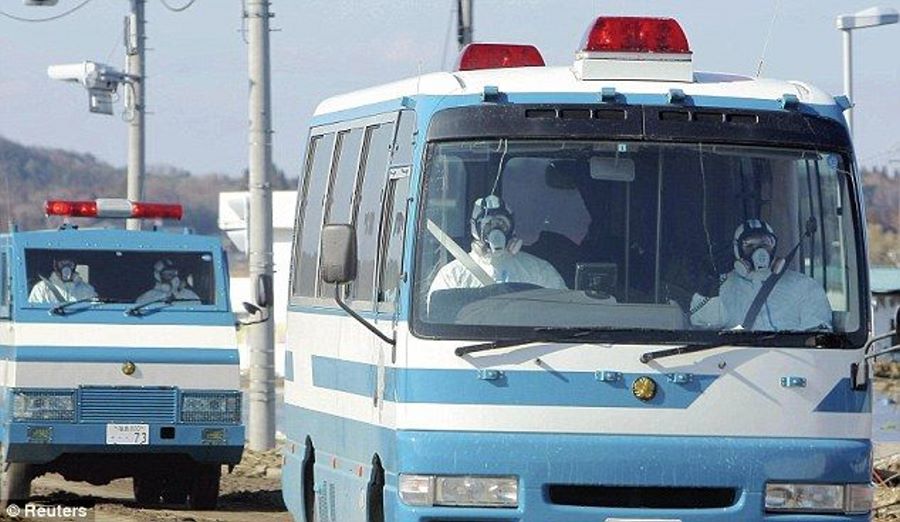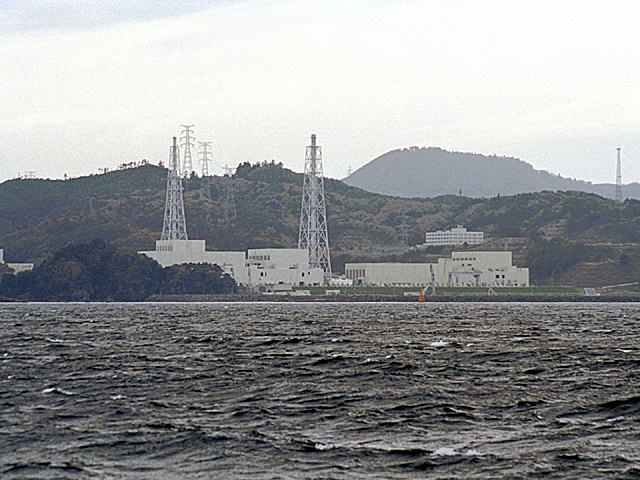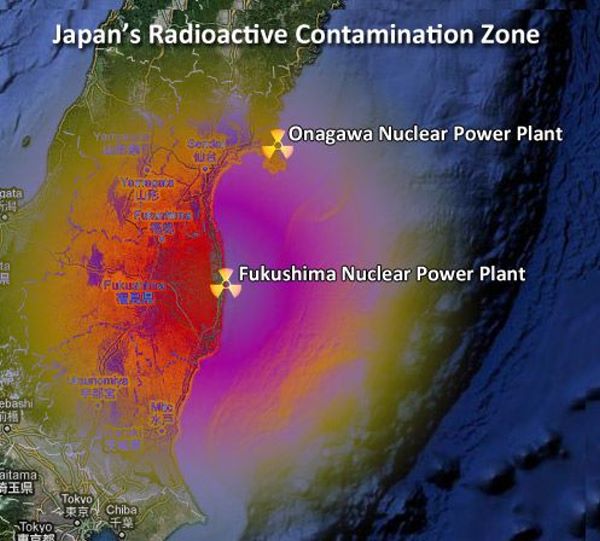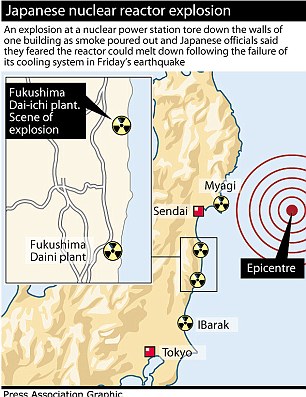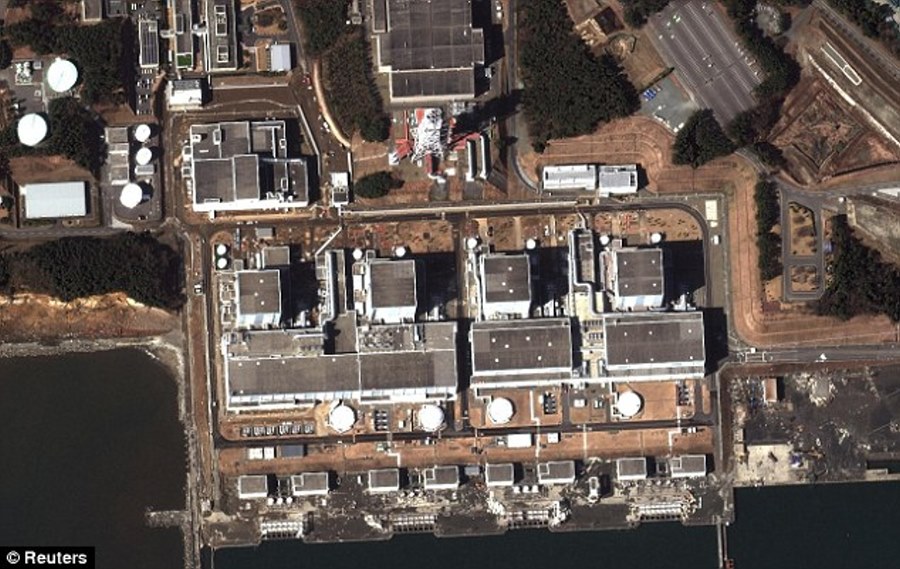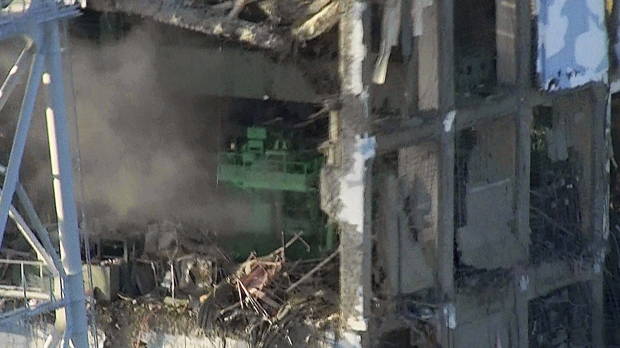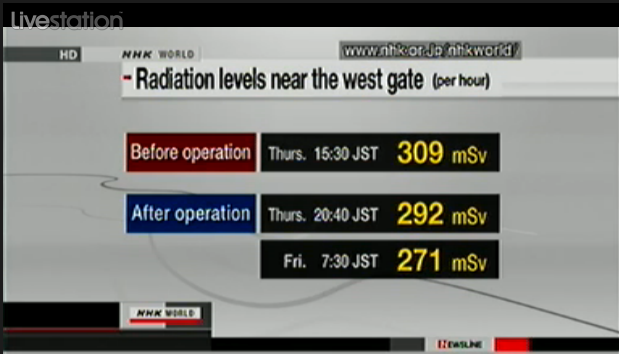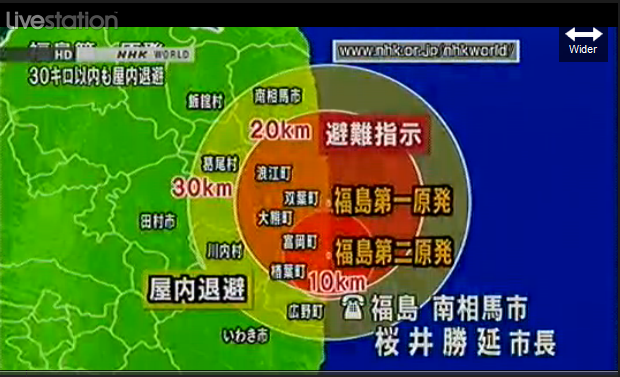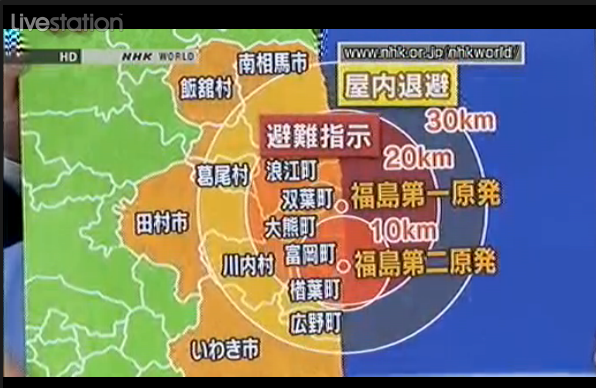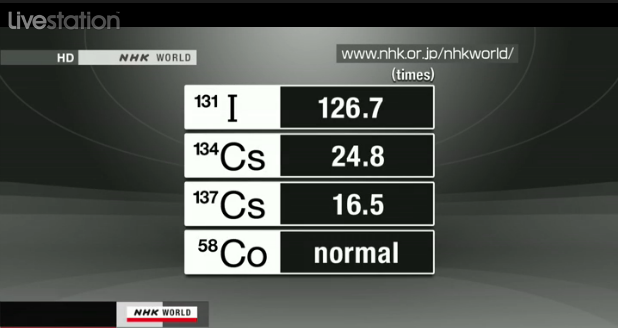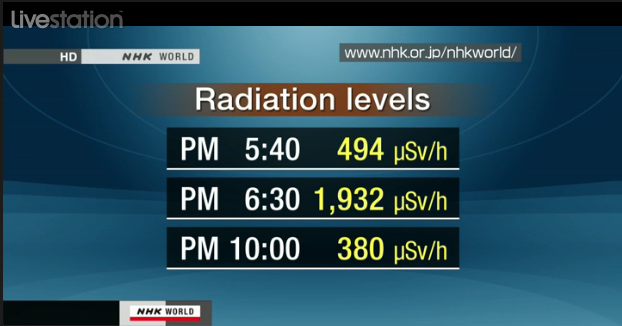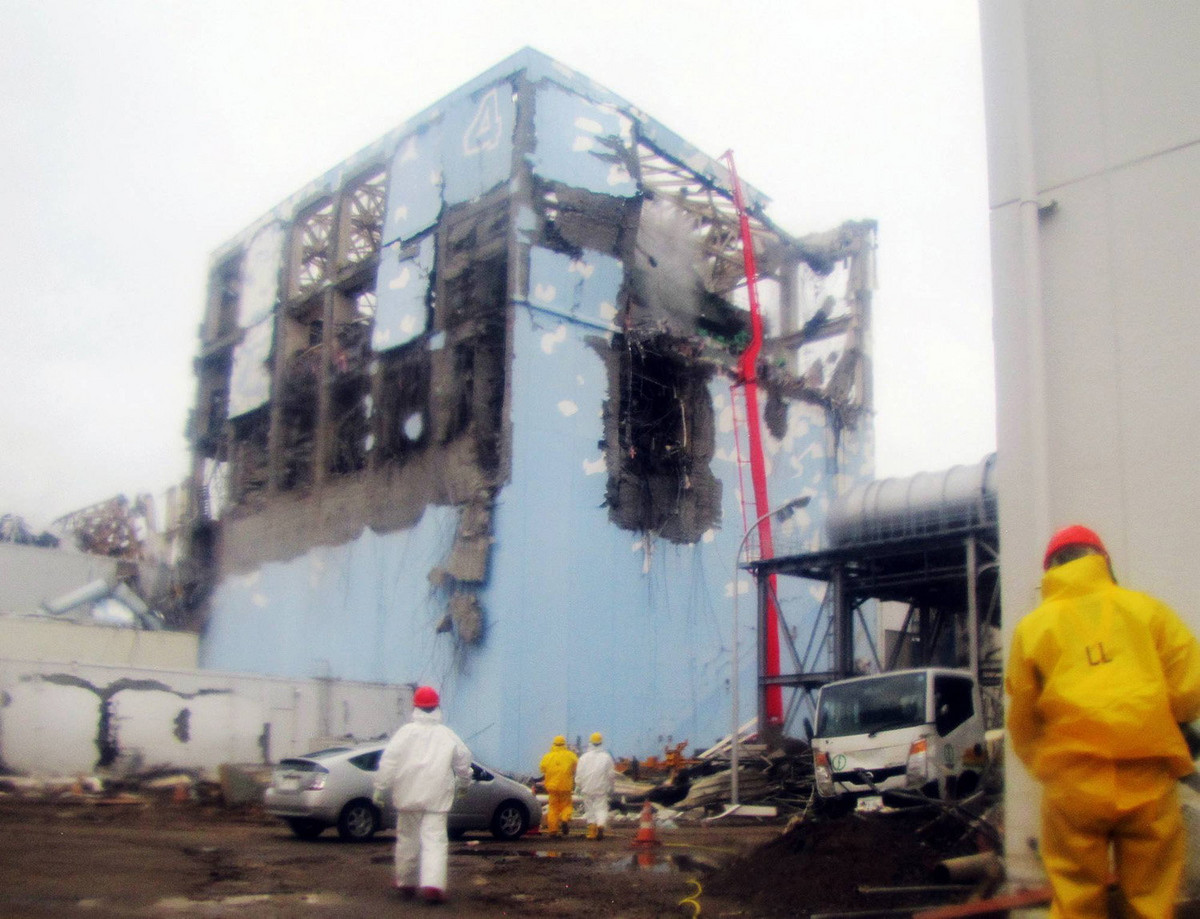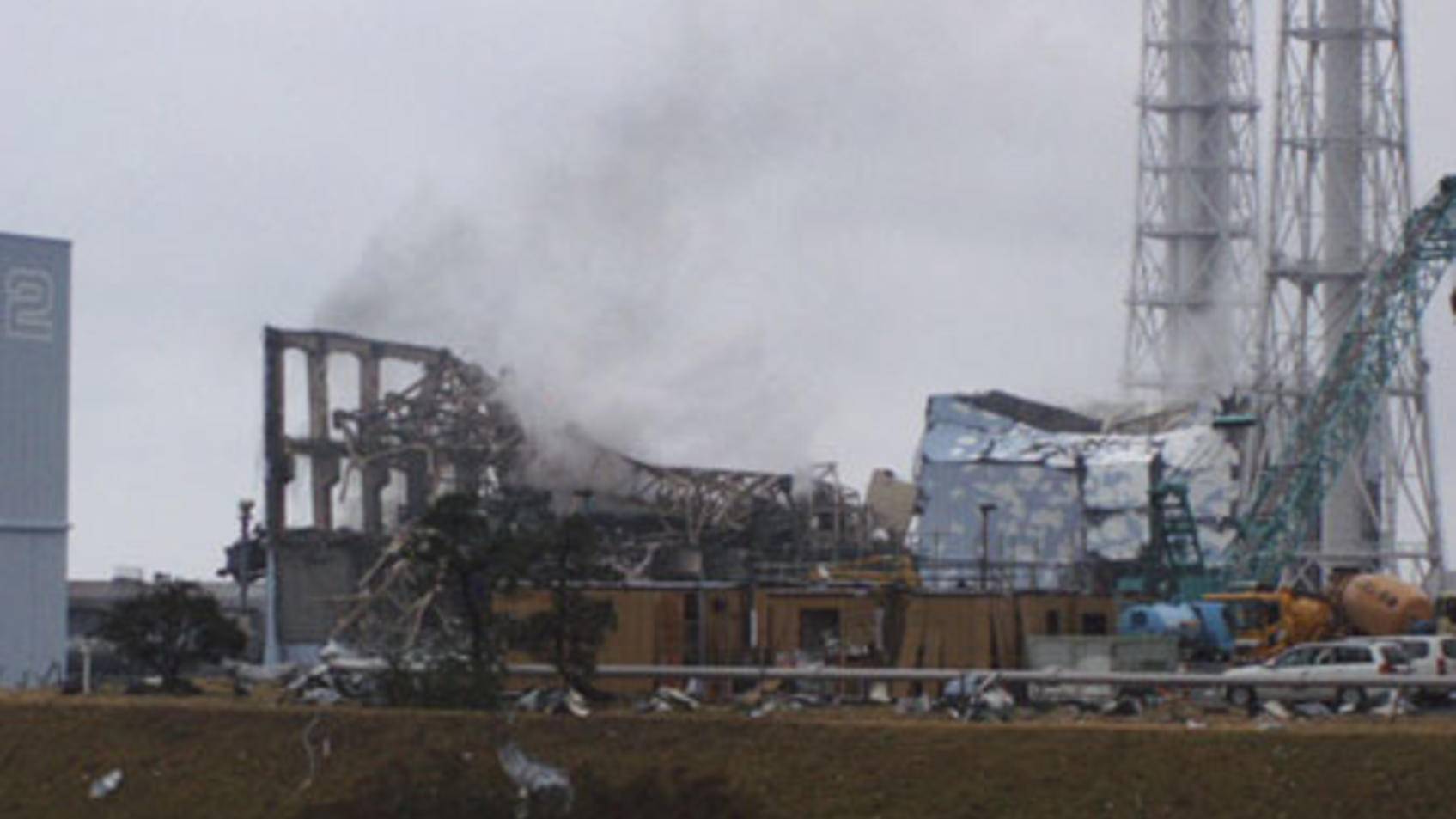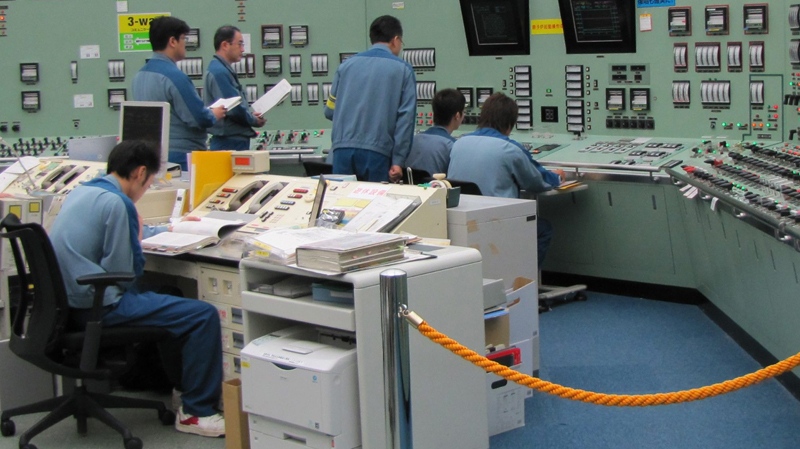|
|
|||||||||||||||||
| Nuclear Emergency - Japan March 2011 Fukushima |
|||||||||||||||||
| March 11th, 2011 Emergency declared at 2nd Japan nuke plant after cooling fails By Michael Winter, USA TODAY Update at 7:21 p.m. ET: Residents within a 2-mile radius of the Fukushima No. 2 plant have been ordered to evacuate, the government has announced. Here's the utility's latest update on the troubles at its overheating nuclear plants. Update at 6:36 p.m. ET: The Japanese government has declared a nuclear emergency at the Fukushima No. 2 power plant (Daini). An emergency also exists at plant No. 1 (Daiichi). Original post: The cooling system has failed for three
reactors at the Fukushima No. 2 nuclear plant, about seven miles from
its quake-crippled companion, the Tokyo Electric Power Co. now says. The utility, which operates both Fukushima plants, notified the government Saturday morning that the failsafe system at the No. 2 plant stopped working as the coolant water topped the boiling point, the Kyodo news service reports.
SOURCE: USA Today |
|||||||||||||||||
|
..
March 12th, 2011
Huge Blast at Japan Nuclear Power Plant A powerful explosion has hit a nuclear power station in north-eastern Japan which was badly damaged in Friday's devastating earthquake and tsunami. A building housing a reactor was destroyed, but the authorities said the reactor itself was intact inside its steel container. The Japanese government has sought to play down fears of a meltdown at the Fukushima plant. It says radiation levels around the stricken plant have now fallen. A huge rescue and relief operation is under way in the region after the earthquake and subsequent tsunami, which are thought to have killed more than 1,000 people. Tokyo Electric Power said four of its workers had been injured in Saturday's blast at Fukushima, 250km (155 miles) north of Tokyo, but that their injuries were not life-threatening. An evacuation zone around the damaged nuclear plant has been extended to 20km (12.4 miles) from 10km, and a state of emergency declared. An estimated 200,000 people have been evacuated from the area, the International Atomic Energy Authority says. SOURCE: BBC
|
|||||||||||||||||
|
screening after explosion in nuclear power station
March 12th, 2011 Thousands undergo radioactive screening after explosion in nuclear power station By Wil Longbottom
The building housing one of Fukushima Dai-ichi's reactors was destroyed in the blast and a cloud of white smoke could be seen pouring from it. Four workers suffered fractures in the explosion, and three were treated for the symptoms of radiation sickness.
The Japanese government said the metal container sheltering the nuclear reactor was not damaged by the explosion. Spokesman Yukio Edano said the radiation around the plant had begun to decrease and that pressure inside the reactor was also going down.
The plant's cooling system had been damaged after the 9-magnitude earthquake struck yesterday and there were fears it could go into meltdown. More...
Footage on Japanese TV showed that the walls of the building had completely collapsed, leaving only a skeletal metal frame standing.
power plant after an explosion this morning - DailyMail
Fukushima Dai-ichi nuclear power plant - DailyMail
and there were fears the reactor could meltdown - DailyMail SOURCE: Daily Mail |
|||||||||||||||||
|
Fukushima Dai-ichi Unit 1 Reactor Schematic
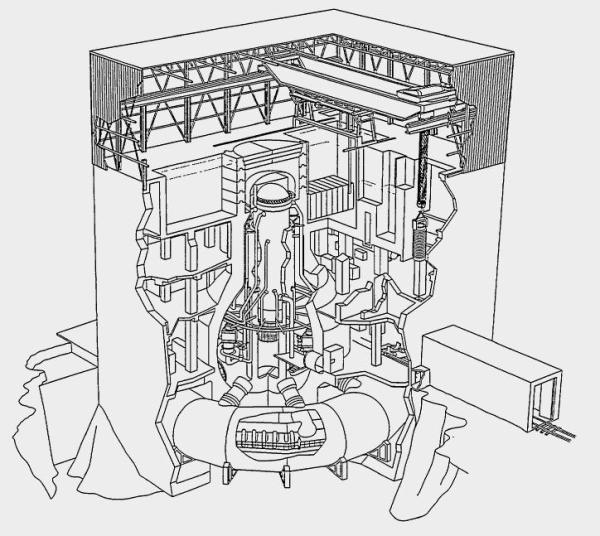 The schematic diagram above shows the GE Mark I Boiling Water Reactor reactor
building structure, the Fukushima Dai-ichi Unit 1. March 12, 2011
The explosion at Fukushima has apparently disintegrated the upper third of the reactor building. The video and pictures currently available indicate that the "blow out panels" of the reactor building and roof cover were blown away by an energetic explosion likely due to a hydrogen gas detonation. The reactor core refuelling deck and the surface of the elevated irradiated nuclear fuel pool are now exposed to the atmosphere. Essentially, the photos show the remaining steel I-beam structure for the weather cover that was over the refueling deck and the top of the "spent fuel" pool. These panels are designed to "blow out" at overpressure. The actual "pressure suppression system" structures credited for containment sit below this structure inside the concrete reactor building, namely the drywell and wetwell or "torus." The drywell is the large inverted lightbulb steel structure which is 100 feet tall and a nominal wall thickness of 1.5 inches. The reactor vessel sits inside this structure. In the event of a coremelt accident involving high pressure and high temperature, the highly radioactive steam and pressure would be vented into the drywell and then routed through the large diameter pipes to the "wet well" or "torus" which is the large 18 foot diameter hollow doughnut-shaped structure that surrounds the drywell. The torus contains approximately 1 million gallons of water and designed to receive the pressurized radioactive steam where it is supposed to be quenched and contained. The status of the reactor containment in the reactor building remains unclear, but apparently remains intact. Fuel damage has apparently occurred because elevated levels of radioactive iodine and cesium are being monitored outside of reactor containment. What is additionally unclear is how much cooling water is left in the fuel storage pools and whether or not there has been damage to irradiated fuel stored in that pool. There are reports of sea water being brought in to cool this facility. Radiation levels are reported to have fallen following the explosion. David Lochbaum, Senior Reactor Safety Engineer for the Union Concerned Scientists, has reported that the explosion may acutally have occurred in the turbine hall building adjacent to the reactor building. An anonymous Japanese government spokesperson has attributed the explosion to the buildup of a combination of hydrogen and oxygen that detonated inside the concrete reactor building but not the crdedited containment structure. Industry reports that the containment structure itself was not compromised or breached by the explosion. Source: Beyond Nuclear |
|||||||||||||||||
Mar 13, 2011 The Onagawa Nuclear Power Plant (女川原子力発電所, Onagawa genshiryoku hatsudensho?, Onagawa NPP) is a nuclear power plant in Onagawa in the Oshika District and Ishinomaki city, Miyagi Prefecture, Japan. It is managed by the Tohoku Electric Power Company. It was the most quickly constructed nuclear power plant in the world. The Onagawa-3 unit was the most modern reactor in all of Japan at the time of its construction. It was used as a prototype for the Higashidori Nuclear Power Plant. The plant conforms fully to ISO 14001, a set of international environmental management standards. The plant's waste heat water leaves 7 degrees Celsius higher than it came in and is released 10 meters under the surface of the water, in order to reduce adverse effects on the environment. All the reactors were constructed by Toshiba. Unit 1 Since November 11, 2006 this unit has been shut down due to the result of a test. Unit 2
The Onagawa Nuclear Power Plant was affected by the 2005 Miyagi earthquake and recorded vibrations above what the plant was designed for. Analysis after the event, however, found no damage to the reactor systems. Some people reported seeing smoke come from the plant after the earthquake and reported it, thinking that it indicated an accident, but the smoke was actually produced by the backup diesel generators. A fire from the turbine section of the plant following the 2011 Sendai earthquake was reported by Kyodo News. On March 13 2011 levels of radiation on site reached 21μSv/hour, a level at which Tohoku Electric Power Company were mandated to declare state of emergency, and they did so at 12:50, declaring the lowest-level such state. Within 10 minutes the level had dropped to 10μSv/hour. The company claimed this was due to radiation from the Fukushima I nuclear accidents and not from the plant itself. SOURCE: Onagawa Nuclear Power Plant
It had earlier been reported that radiation levels around the Onagawa nuclear plant were higher than considered safe, and that because of that a state of emergency had been declared, but now it seems wind was a factor in that incident. The International Atomic Energy Agency (IAEA), the U.N.'s nuclear agency, said earlier that Japan had declared a state of emergency at the Onagawa nuclear power plant. An investigation into the source of the over-the-limit radioactivity at the Onagawa power plant turned up a natural source: wind. The Onagawa nuclear power plant has three reactors. Authorities now say that the increased nuclear radiation around the Onagawa power plant is due to radioactive material blown from the neartby Fukushima Power Plant, which had one reactor unit explode on Saturday. The explosion appears to have been caused by a buildup of hydrogen gas in the containment unit around the reactor vessel. The reactor itself was not damaged, authorities say.
Meanwhile, on Sunday, officials have announced that a second reactor at the Fukushima power plant is in danger of experiencing a similar explosion. Unit 3 is the latest of the reactors to be in danger. It was Unit 1 that exploded on Sunday. Experts have added that favorable winds will protect other nations from contamination. Winds will blow any radiation to the Pacific, in such a way as to avoid other nations, experts said. SOURCE: Michael Santo |
|||||||||||||||||
| March 13, 2011 Military Crew Said to Be Exposed to Radiation, but Officials Call Risk in U.S. Slight By WILLIAM J. BROAD The Pentagon was expected to announce that the aircraft carrier Ronald Reagan, which is sailing in the Pacific, passed through a radioactive cloud from stricken nuclear reactors in Japan, causing crew members on deck to receive a month’s worth of radiation in about an hour, government officials said Sunday. The officials added that American helicopters flying missions about 60 miles north of the damaged reactors became coated with particulate radiation that had to be washed off. There was no indication that any of the military personnel had experienced ill effects from the exposure. (Everyone is exposed to a small amount of natural background radiation.) But the episodes showed that the prevailing winds were picking up radioactive material from crippled reactors in northeastern Japan. Ever since an earthquake struck Japan on Friday, the authorities worldwide have been laying plans to map where radioactive plumes might blow and determine what, if any, danger they could pose to people. Blogs were churning with alarm. But officials insisted that unless the quake-damaged nuclear plants deteriorated into full meltdown, any radiation that reached the United States would be too weak to do any harm. Washington had “hypothetical plots” for worst-case plume dispersal within hours of the start of the crisis, a senior official said Sunday. The aim, the official added, was “more to help Japan” than the United States, since few experts foresaw high levels of radiation reaching the West Coast. For now, the prevailing winds over Japan were blowing eastward across the Pacific. If they continue to do so, international stations for radioactive tracking at Wake or Midway Islands might detect radiation later this week, said Annika Thunborg, a spokeswoman for an arm of the United Nations in Vienna that monitors the planet for spikes in radioactivity. “At this point, we have not picked up anything” in detectors midway between Japan and Hawaii, Ms. Thunborg said in an interview on Sunday. “We’re talking a couple of days — nothing before Tuesday — in terms of picking something up.” Agencies involved in the tracking efforts include the World Meteorological Organization, the International Atomic Energy Agency and the Comprehensive Test Ban Treaty Organization, which runs a global network of more than 60 stations that sniff the air for radiation spikes. In the United States, the Departments of Defense and Energy maintain large facilities and cadres of specialists for tracking airborne releases of radiation, both civilian and military. On Sunday, the Nuclear Regulatory Commission said it expected no “harmful levels of radioactivity” to move on the winds to Hawaii, Alaska or the West Coast from the reactors in Japan, “given the thousands of miles between the two countries.” In interviews, some private nuclear experts called a windborne threat unlikely. Others urged caution. “We’re all worrying about it,” said Robert Alvarez, a nuclear expert who, from 1993 to 1999, was a policy adviser to the secretary of energy, who runs the nation’s nuclear complex. “It’s going to be very important,” he added, “for the Japanese and U.S. authorities to inform the public about the nature of the plumes and any need for precautionary measures.” The plume issue has arisen before. In 1986, radiation spewing from the Chernobyl disaster in Ukraine was spread around the globe on winds and reached the West Coast in 10 days. It was judged more of a curiosity than a threat. Since then, scientists have refined their abilities to monitor such atmospheric releases. The advances are rooted in the development of new networks of radiation detectors, flotillas of imaging satellites and the advent of supercomputers that can model the subtle complexities of the wind to draw up advanced forecasts. With the Japanese crisis, popular apprehension has also soared. “Concern has been raised about a massive radioactive cloud escaping and sweeping over the West Coast,” said a recent blog, recommending whole grains and health foods for fighting radiation poisoning. On another blog, someone asked, “Should I take iodine now?” That referred to pills that can prevent poisoning from the atmospheric release of iodine-131, a radioactive byproduct of nuclear plants that the Japanese authorities have identified as escaping into the atmosphere. While federal officials expected little danger in the United States from Japanese plumes, they were taking no chances. On Sunday, Energy Department officials, speaking on the condition of anonymity, said the agency was working on three fronts. One main player is the Lawrence Livermore National Laboratory in California. Officials said they had activated its National Atmospheric Release Advisory Center, which draws on meteorologists, nuclear scientists and computer scientists to forecast plume dispersal. Separately, energy officials said the agency was readying plans to deploy two-person monitoring and sampling teams, if necessary. The teams would travel to consulates, military installations and Navy ships to sample the air in a coordinated effort to improve plume tracking. Finally, the department was preparing what it calls its Aerial Measuring System. Its detectors and analytical equipment can be mounted on a variety of aircraft. Officials said the equipment and monitoring team are staged out of the department’s Remote Sensing Laboratory at Nellis Air Force Base in Nevada, and are on two-hour call. “We’re on top of this,” a department official said. David E. Sanger contributed reporting from Washington. SOURCE: NEW YORK TIMES The New York Times Reprints |
|||||||||||||||||
|
March 14, 2011
nuclear plant before the explosions - Daily Mail
Fukushima I Nuclear Power Plant Reactor 3 explosion March 14, 2011 ..
Follow latest updates at http://twitter.com/rt_com and
http://www.facebook.com/RTnews Tokyo's utility company said on
Wednesday that black smoke has been seen emerging from Unit 3 of the
crippled nuclear plant in northeastern Japan, prompting a new
evacuation of the complex. Officials with Tokyo Electric Power Co. said
on Wednesday that workers from the entire Fukushima Dai-ichi plant have
been temporarily evacuated. Operators of the power station have been
desperately trying to cool the reactors and spent fuel pools at the
plant after it was damaged by this month's tsunami, which knocked out
power to the cooling systems.
|
|||||||||||||||||
| March 14th, 2011 Originally posted by okiecowboy ATS Post ID 10805818 Ok I am not as good providing well written and explained posts as Zorgon or TheRedneck so bear with me.. The Big picture as I see it I am going to ignore the reactors themselves for a bit and talk about the storage of the spent fuel rods and possible fire of same... In Japan the spent fuel rods are stored mainly at the plant, with a portion sent to another plant to reprocess... without posting the diagrams that have been posted many times before... spent fuel is stored within the reactor building in a swimming pool-like concrete structure near the top of the reactor vessel. This spent fuel must be kept underwater to prevent severe releases of radioactivity, among other reasons. A meltdown or even a fire could occur if there is a loss of coolant from the spent fuel pool. The water in the spent fuel pool and the roof of the reactor building are the main barriers to release of radioactivity from the spent fuel pool.Notice it said water and the roof are the main barriers...we have plants missing the roof and lack of water has been mentioned many times. Now the reason for the missing roof has been explained as a hydrogen build up due to venting from the steam to release pressure in the reactor. Hydrogen is generated in a nuclear reactor if the fuel in the reactor loses its cover of cooling water. The tubes that contain the fuel pellets are made of a zirconium alloy. Zirconium reacts with steam to produce zirconium oxide and hydrogen gas. Moreover, the reaction is exothermic – that is, it releases a great deal of heat, and hence creates a positive feedback that aggravates the problem and raises the temperature.So how much fuel are we talking here. it's hard to get the exact number but; The Fukushima Daiichi plant has seven pools for spent fuel rods. Six of these are (or were) located at the top of six reactor buildings. One “common pool” is at ground level in a separate building. Each “reactor top” pool holds 3450 fuel rod assemblies. The common pool holds 6291 fuel rod assemblies. [The common pool has windows on one wall which were almost certainly destroyed by the tsunami.] Each assembly holds sixty-three fuel rods. This means the Fukushima Daiichi plant may contain over 600,000 spent fuel rodsand; Japanese commercial nuclear power plants began operation in 1970. Currently there are 53 nuclear power plants in operation. To date close to 20,000 tons of spent nuclear fuel has been generated by Japan's nuclear power programStarting to get a warm fuzzy feeling yet? Now remember one of these reactors is using MOX fuel. which has been explained several times... Mox is a fuel that contains plutonium. Okay so what if we have a spent fuel fire, how bad can it be? Well this type of thing has been studied before, just not in Japan. We have some U.S. studies we will use; If a fire were to break out at the Millstone Reactor Unit 3 spent fuel pond in Connecticut, it would result in a three-fold increase in background exposures. This level triggers the NRC’s evacuation requirement, and could render about 29,000 square miles of land , according to Thompson. Connecticut covers only about 5,000 square miles; an accident at Millstone could severely affect Long Island and even New York CityAlso from the same article; Several events could cause a loss of pool water, including leakage, evaporation, siphoning, pumping, aircraft impact, earthquake, accidental or deliberate drop of a fuel transport cask, reactor failure, or an explosion inside or outside the pool building. Industry officials maintain that personnel would have sufficient time to provide an alternative cooling system before the spent fuel caught fire. But if the water level dropped to just a few feet above the spent fuel, the radiation doses in the pool building would be lethal.Again this study did not factor in MOX fuel and another article says; The consequences of severe spent fuel pool accidents at closed U.S. reactors were studied by the Brookhaven National Laboratory in a 1997 report prepared for the U.S. Nuclear Regulatory Commission. According to the results, the damages resulting from such accidents for U.S. Boiling Water Reactors could range from $700 million to $546 billion, which would be between roughly $900 million and $700 billion in today’s dollars. The lower figures would apply if there were just one old spent fuel set present in the pool to a full pool in which the spent fuel has been re-racked to maximize storage. Other variables would be whether there was any freshly discharged spent fuel in the pool, which would greatly increase the radioactivity releases. The estimated latent cancer deaths over the years and decades following the accident was estimated at between 1,300 and 31,900 within 50 kilometers (30 miles) of the plant and between 1,900 and 138,000 within a radius of 500 kilometers (300 miles) from the plant.So what if we have a spent fuel fire at plant number one? “That would be like Chernobyl on steroids,” said Arnie Gundersen, a nuclear engineer at Fairewinds Associates and a member of the public oversight panel for the Vermont Yankee nuclear plant, which is identical to the Fukushima Daiichi unit 1So let's pretend for a minute it does happen... and let's pick a number from the above listed report of 1000 square miles ( report said up to 29,000 miles... I went with a lower figure just cuz) Now to me uninhabitable means... Not Habitable ..ie.. get the heck out.. so a wide area becomes a ghost town. But wait a minute... we have important things in that area that have to be tended to and monitered right? Another nuke plant nearby right? And a plant at Onagwa that is already showing trouble... we can's just up and leave. Anyone remember the Tokai plant? It is a small reconversion plant with a little fame already. The Tokaimura nuclear accident (東海村JCO臨界事故, Tōkai-mura JCO-rinkai-jiko?, "Tōkai Village JCO Criticality Accident") was at the time Japan's worst civilian nuclear radiation accident. It took place on 30 September 1999 at a uranium reprocessing facility located in the village of Tōkai, Naka District, Ibaraki. The accident occurred in a very small fuel preparation plant operated by JCO (formerly Japan Nuclear Fuel Conversion Co.), a subsidiary of Sumitomo Metal Mining CoRemember all that MOX fuel we talked about before, that may or may not be in storage at the plant? Well within a not so far area of the plant that may or may not be dumping radiation out is Rokkasho Reprocessing Plant; The Rokkasho Reprocessing Plant (六ヶ所村核燃料再処理施設, Rokkasho Kakunenryō Saishori Shisetsu?) is a nuclear reprocessing plant with an annual capacity of 800 tons of uranium or 8 tons of plutoniumRokkasho has a Spent fuel storage pool that has already had trouble in the past; Other safety problems have plagued Rokkasho. Last year, the cooling system of its spent nuclear fuel storage pool temporarily failed. The ventilation system in the fuel storage building had problems. Last month, the fuel pool, which at that point contained more than 1,000 nuclear fuel assemblies, leaked coolant from a loose valve; it took workers more than 15 hours to identify and fix the problemDoes this sound like a area people can just up and walk away from? And this is just a partial list of man power critical list. So as this story unfolds and the evacuation zones keep expanding, think about what people may have to walk away from. |
|||||||||||||||||
|
March 16, 2011
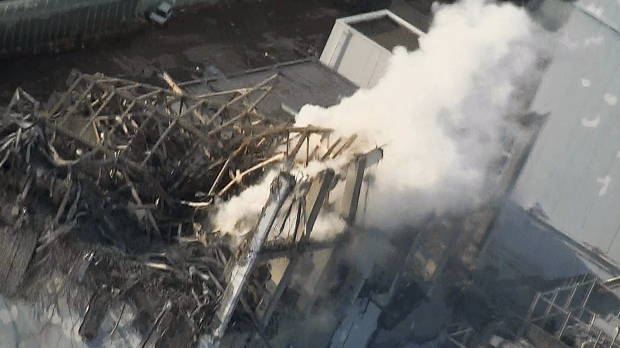 (AP Photo/Tokyo Electric Power Co. via Kyodo News) In this photo taken Wednesday, March
16, 2011 and released by Tokyo Electric Power Co. via Kyodo News
Friday, smoke billows from wrecked unit 3 at Japan's crippled Fukushima
Dai-ichi nuclear power plant in Okumamachi, Fukushima Prefecture.
In this photo taken Wednesday, March 16, 2011 and released by Tokyo Electric Power Co. via Kyodo News Friday, smoke billows from wrecked unit 4 at Japan's crippled Fukushima Dai-ichi nuclear power plant in Okumamachi, Fukushima Prefecture. Globe and Mail |
|||||||||||||||||
|
March 17,
2011 posted
@ 11:00 PM
|
|||||||||||||||||
|
March 19, 2011
Japan reluctant to disclose footage of power plant taken by U.S. drone  The Japanese government has in its possession video footage of the Fukushima No. 1 Nuclear Power Plant taken by a U.S. military reconnaissance drone, but has yet to release the footage to the public, sources have revealed. The footage taken from an RQ-4 Global Hawk drone was passed on to the Japanese government with permission for public release from the U.S. Air Force. U.S. military sources said that the decision to release the footage -- or not -- was up to the Japanese government. The unmanned aerial vehicle (UAV) is equipped with a high-performance camera that, according to the U.S. Air Force, takes "footage so clear that even automobile license plates are visible." Nearly real-time footage of the internal state of the power station is said to be captured, which is likely to assist experts in analyzing the situation. The U.S. Air Force has been flying the state-of-the-art UAV based in Andersen Air Force Base, Guam, over quake- and tsunami-ravaged areas since March 12 -- a day after a massive quake and tsunami struck eastern Japan -- in response to a request from the Japanese government. Because Japanese Self-Defense Force aircraft have trouble flying over the stricken Fukushima power plant due to large amounts of radioactive materials detected in the air, the Global Hawk has been filming the area around the clock. Footage is transmitted via satellite to a U.S. Air Force base in California, and is also supplied to the Japanese government. The Japanese government, however, has yet to disclose the footage, which is being analyzed by nuclear power experts and others at the California base. Click here for the original Japanese story (Mainichi Japan) March 19, 2011 |
|||||||||||||||||
|
March 21,
2011
|
|||||||||||||||||
|
HD
Flight over Fukushima I NPP-25%slowdown-stabilized
March 22, 2011 excerpts of the most important scenes of the helicopter flight over Fukushima I NPP on 15th march - 25% slowed down - motion frames interpolated - higher resolution |
|||||||||||||||||
Workers
in protective suits conduct cooling operation by spraying water at the
damaged No. 4 unit of the Fukushima Dai-ichi nuclear complex in Okuma,
northeastern Japan, Tuesday, March 22, 2011. (Tokyo Electric Power Co.
via Kyodo News)
|
|||||||||||||||||
Related Links:
|
|||||||||||||||||
|
April 06, 2011
http://www.soumu.go.jp/menu_news/s-news/01kiban08_01000023.html http://www.soumu.go.jp/main_content/000110048.pdf
Tepco radiation site map
Civil Society Gaining Ground Following Quake
Periodic health checkups mulled for Fukushima residents
Primordial fear: why radiation is so scary
http://theintelhub.com/2011/04/23/dr-mark-sircus-radioactive-currents-and-winds/ Human embryos in US likely bioaccumulating radioactive iodine, cesium, and strontium says physician who taught at Harvard Med School April 10th, 2011 at 06:58 AM http://enenews.com/human-embryos-bioaccumulating-radioactive-iodine-cesium-strontium-physician-taught-harvard-med-school Monday, April 25, 2011
BP Confirms Shipping Unit Has Added Radiation Clause To Contracts
2011/04/25 15:31 KST
Anti-nuclear plant candidates secure some seats in local elections
Agence France Presse - Japan launches new mass search for bodies
Step up fight against harmful rumors about Japan goods
Times-Picayune - N.O. lawyer travels the world to save disaster-struck
pets
Agence France Presse - Anti-nuclear protests on Franco-German border Apr 25 06:46 AM US/Eastern www.breitbart.com/article.php?id=CNG.e738123e4ccce6019851c695501ca633.541&show_article=1 TEPCO to halve executive pay amid Fukushima nuclear reactor crisis (VIDEO)
How did Japan's nuclear industry become so arrogant?
http://www.bbc.co.uk/news/world-asia-pacific-12996971
http://mdn.mainichi.jp/mdnnews/news/20110421p2a00m0na018000c.html
[url=http://www.houseoffoust.com/fukushima/blueprint.html]Blueprint for Unit 1[/url] [url=http://fukushimafaq.wikispaces.com/3D+and+Autocad+Rendering+%26+Analysis]3D rendering of Units 2-5[/url] [url=http://www.houseoffoust.com/fukushima/possibles.html]All kinds of stuff[/url]
http://www.world-nuclear.org/info/inf79.html Japanese Waste and MOX Shipments from Europe - Appendix 1
Nuclear Power Plants and Earthquakes
http://www.nytimes.com/2011/04/27/world/asia/27collusion.html?pagewanted=4 http://www.meti.go.jp/english/speeches/20101015.htmlRadiation Readings in Fukushima Reactor Rise to Highest Since Crisis
Began
Fukushima Prefecture starts taking custody of pets left in 20-km no-entry
zone
45 children still in town where high levels of radiation have been detected
2011/04/28 16:21 KST
Friday, April 29, 2011
explosive disassembly of supercritical reactor core
Japan prime minister's nuclear adviser resigns
Saturday, April 30, 2011
Kyodo News International - Weather chief draws flak over plea not to
release radiation forecasts
Gov't panel releases 2 of over 2,000 radiation dispersal estimates
http://www.youtube.com/watch?v=BL1kcB1ClBk
Seabed radiation 100-1,000 times normal level off Fukushima plant TOKYO, May 3, Kyodo Radiation readings have risen to 100-1,000 times the normal level on the Pacific seabed near the crippled Fukushima Daiichi nuclear power plant, the operator said Tuesday. http://english.kyodonews.jp/news/2011/05/89167.html
Police to compile DNA database in 3 tsunami-hit prefectures
Miyagi Panel Member Wants Solar Power for All Rebuilt Homes
Jiji Press Ticker Service
Japan nuclear plant operations (Japan Atomic to shut unit)
http://www.novinite.com/view_news.php?id=127874 |
|||||||||||||||||
| FAIR USE NOTICE: This page contains copyrighted material the use of which has not been specifically authorized by the copyright owner. Pegasus Research Consortium distributes this material without profit to those who have expressed a prior interest in receiving the included information for research and educational purposes. We believe this constitutes a fair use of any such copyrighted material as provided for in 17 U.S.C § 107. If you wish to use copyrighted material from this site for purposes of your own that go beyond fair use, you must obtain permission from the copyright owner. | |||||||||||||||||
|
|
